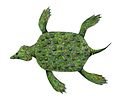| Psephochelys Temporal range: Late Triassic | |
|---|---|
 | |
| Fossil specimen | |
| Scientific classification | |
| Domain: | Eukaryota |
| Kingdom: | Animalia |
| Phylum: | Chordata |
| Class: | Reptilia |
| Superorder: | † Sauropterygia |
| Order: | † Placodontia |
| Family: | † Placochelyidae |
| Genus: | † Psephochelys Li and Rieppel, 2002 |
| Type species | |
| †Psephochelys polyosteoderma Li and Rieppel, 2002 | |
Psephochelys (meaning "pebbly turtle") is an extinct genus of placodont reptile from the Late Triassic of China. It is represented by a single species, Psephochelys polyosteoderma, named in 2002 on the basis of a single partial skeleton found in an outcrop of the Carnian-age Falong Formation in Guizhou Province. Psephochelys is classified as a member of the family Placochelyidae, which is within the larger placodont superfamily Cyamodontoidea. Like other cyamodontoids, Psephochelys has a wide shell covering its body, similar to that of a turtle. However, unlike those of other cyamodontoids, the shell of Psephochelys only covers its back. The plastron, which covers the underside of other cyamodontoids, is absent, and in its place are rib-like gastralia surrounded by loosely connecting osteoderms or bony plates. [1]






